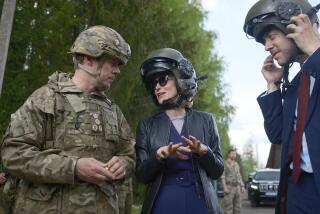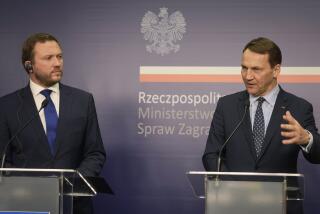Estonia Seeks to Preserve Identity Amid Russian Influx
- Share via
TALLINN, Soviet Union — The young woman in the candle-lit cellar cafe talked in low tones about her attitude toward the increasing number of Russians here in the Soviet Republic of Estonia.
“I don’t dislike Russians,” she said, “I just don’t think they belong here.”
Her attitude is not uncommon in Estonia, a land profoundly influenced by Western traditions and seldom free of what its independent-minded people regard as foreign rule.
Native Estonians make up about 60% of the republic’s population, which totals 1.5 million, but Russians are believed to be the majority in Tallinn, and some Estonians fear that their culture and their language may be in danger of being displaced.
Not long ago the Estonian doorman at one of the city’s most elegant restaurants refused to admit a Russian who insisted that he had reserved a table two hours earlier.
Russian Greeting Ignored
When an Estonian taxi driver heard a greeting in Russian from a passenger, he stared ahead in stony silence. Later, when asked how much he was owed, the driver pointed to the meter. He pocketed the money without a word of thanks.
Life in the cobbled, crooked streets of this old city reflects an outlook that has more the flavor of Western Europe than the Soviet Union.
The red banners with admonitory slogans that are so common elsewhere in the Soviet Union are conspicuous by their absence in Tallinn. Instead the eye is drawn by church steeples and ancient iron signs marking the location of shops and cafes.
In contrast with Moscow, with its traffic policeman at every major intersection, Tallinn seems to get along without any visible symbols of authority.
Citizens of neighboring Latvia, which also has a proud cultural legacy, also harbor a quiet resentment of Russians living in their republic but not speaking their language.
Fallout From Pact
After 20 years of independence between World Wars I and II, Estonia, Latvia and Lithuania fell under Soviet control in 1940 as part of the fallout from the nonaggression pact signed with Nazi Germany the previous year.
A recent visitor to Riga was told of statues that have been erected to honor Latvian Communists who were executed in Josef Stalin’s purges of the 1930s.
Now the three Baltic republics are more prosperous than much of the Russian Federation and other parts of the Soviet Union. They are sometimes called “the Soviet West.” Church attendance by Roman Catholics in Lithuania and Latvia, and by Lutherans in Latvia and Estonia, is believed to be higher than in most other parts of the country despite the government’s atheist stand.
Estonia is reported to have more cars per capita--about one for every 10 people--than any place of its size in the Soviet Union. Cafes and restaurants, as attractively designed and furnished as any in Western Europe, are generally crowded.
Television habits here have been influenced by the availability of TV signals from Finland. Many Estonians tune in Finnish channels to follow American series like “Dynasty” and “Dallas.”
Consumer Goods Shortages
Despite their differences, however, the three Baltic states share some problems with the 12 other Soviet republics. Shortages of consumer goods, for example, appear to be as common here as throughout the Soviet Union. On a recent afternoon in Riga, scores of people were lined up to buy toilet paper.
In Tallinn there were long lines of people waiting to buy cotton candy, still a new taste sensation here, at the only place in the city where it is sold.
Poor construction and housing repairs also afflict the Baltic states. In Tallinn and Riga, many new apartments are in such poor condition that, as in other parts of the Soviet Union, instant renovation is needed before they can be occupied. In Tallinn, a new cooperative has been established to specialize in just such repairs.
Polish technicians have been imported to restore centuries-old buildings in Tallinn and Riga.
On a recent tour of Latvia and Estonia, Soviet leader Mikhail S. Gorbachev focused on some of the major economic problems in the Baltic area. He was sharply critical, describing as “obsolete” a streetcar produced in Latvia, and urging Estonians to do much better in livestock and grain production.
But Gorbachev found comfort in his view of the gains achieved here since 1940.
“Going back into history, we see the peasants and workers of the Baltic territories in common formation with the Russian proletariat,” he said. “Our very reality rebuts the malicious and slanderous fabrications of reactionary emigre circles and their Western patrons.”
More to Read
Sign up for Essential California
The most important California stories and recommendations in your inbox every morning.
You may occasionally receive promotional content from the Los Angeles Times.









